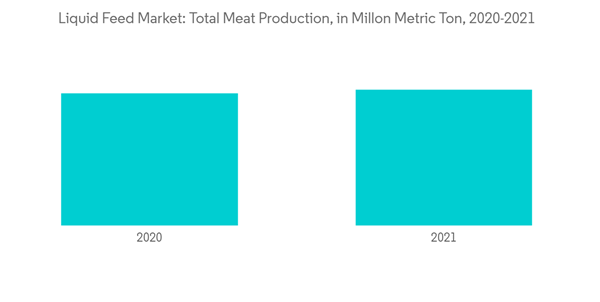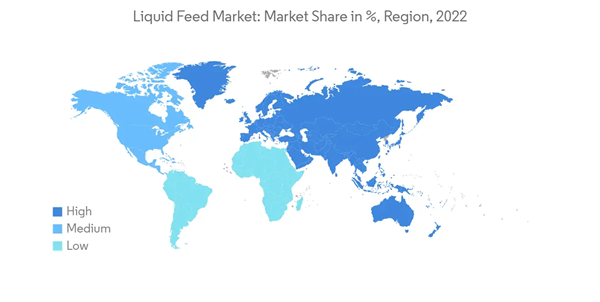The Liquid Feed Market size is estimated at USD 85.08 billion in 2024, and is expected to reach USD 113.97 billion by 2029, growing at a CAGR of 6.02% during the forecast period (2024-2029).
According to the OECD Report 2021, the total meat production remained stable in 2020 at an estimated 328 metric tons, as output increases in poultry and ovine meats offset contractions in pig and bovine meat production. Total poultry meat production in 2020 is estimated at 134 metric tons, up 1.2 % from 2019, underpinned by a sharp rise in demand in China.
Furthermore, the Economic Research Services, US Department of Agriculture, reports that the total consumption of beef in the United States has increased from 55 pounds per capita in 2019 to 58.4 pounds per capita in 2020 and is projected to further rise steadily over the coming years. With vitamins, minerals, and feed additives as part of the composition, a liquid feed supplement is an emerging economical source of balanced nutrition for livestock to cater to the growth of livestock production worldwide.
The demand for seafood is increasing rapidly as more and more people are becoming aware of the health benefits of fish consumption. Increasing life expectancy and limited availability of land and water resources for animal feed production and increasing use of these resources for food and ethanol production are increasing the demand for animal feed in the global meat industry.
The countries in the region are driving the liquid feed market owing to changing consumption patterns toward more protein-based products, including meat. China is one of the fastest-growing markets, with the country's Feed Industry Association emphasizing the maintenance of minimum protein levels in livestock feed. The other liquid feed supplement markets in the region, including Vietnam, which is the second-largest pork consumer, and India, which is the most potential market for liquid feed supplements, driven by an increasing trend in the intensive farming system, are contributing to the demand for liquid feed supplements in the entire Asia-Pacific belt.
The growth of the feed industry in China has led global compound feed players like Archer Daniels Midland and Cargill to expand and open their new facilities in China. The Zhangzhou feed factory of Archer Daniels Midland Company in China is the fourth compound production facility of the company, which has an annual capacity of 30,000 metric tonne of feed premixes and 80,000 metric tonne of complete feed and concentrates. Cargill has invested in a new premix facility in China to continue growing its feed presence in the region. Sorghum growers in the United States got a big boost when the USDA revealed record sales to China in 2020. According to the National Sorghum Producer, a soy grower body in the USA, the demand surge led by China's animal feed industry was the reason for rising sorghum imports in China.
This product will be delivered within 2 business days.
Key Highlights
- The liquid feed market is projected to experience strong development due to an increase in animal-based food product consumption worldwide. Shifting customer dietary habits toward quality dairy products and meat is expected to contribute to the growth of the liquid feed market over the forecast period. The rapidly growing commercialization of the livestock industry (from feeding to processing) has generated significant demand for nutrient-rich feed supplements in the region. The rising demand for animal products such as meat and dairy has put significant pressure on livestock farmers to improve their competence.
- According to the FAO, North America's total number of cattle and buffaloes was 104,847.4 heads, followed by Europe at 115,190.9 heads, South America at 115,190.9 heads, and Asia at 667,687.5 heads, Oceania at 35,010.1 heads, and Africa at 374,461.8 heads in 2021. The region occupies larger animal farms and a huge number of animals. The vast cattle population that requires feed supplements in huge quantities has been driving the market's growth. Therefore, with the rising demand for liquid feed from large-sized farms, the market is anticipated to grow in the coming years.
- With the rising meat consumption worldwide, the liquid feed industry is estimated to witness a huge demand for better-quality meat. According to the FAO, global consumption of meat proteins in the future is estimated to rise by 14% by 2030, compared to 2018-2020, propelled largely by population growth and income. Protein availability from poultry, beef, pork, and sheep meat is expected to grow by 17.8%, 5.9%, 13.1%, and 15.7%, respectively, by 2030.
Liquid Feed Market Trends
Increase in the Production of Meat and Aquaculture Products
The growing demand for high-grade meat and meat products from health-conscious consumers has spurred the production of meat, hence boosting the liquid feed supplement market globally. Owing to the advantages such as better digestibility in animals, simplified and flexible addition of additives, and the possibility of fermentation, the demand for liquid feed supplements is rising rapidly to aid the production of high-quality meat. According to the USDA report, the total meat consumption accounted for 11,850 metric tons during the year 2021 which is higher than the previous year's stated 11,732 metric tons.According to the OECD Report 2021, the total meat production remained stable in 2020 at an estimated 328 metric tons, as output increases in poultry and ovine meats offset contractions in pig and bovine meat production. Total poultry meat production in 2020 is estimated at 134 metric tons, up 1.2 % from 2019, underpinned by a sharp rise in demand in China.
Furthermore, the Economic Research Services, US Department of Agriculture, reports that the total consumption of beef in the United States has increased from 55 pounds per capita in 2019 to 58.4 pounds per capita in 2020 and is projected to further rise steadily over the coming years. With vitamins, minerals, and feed additives as part of the composition, a liquid feed supplement is an emerging economical source of balanced nutrition for livestock to cater to the growth of livestock production worldwide.
The demand for seafood is increasing rapidly as more and more people are becoming aware of the health benefits of fish consumption. Increasing life expectancy and limited availability of land and water resources for animal feed production and increasing use of these resources for food and ethanol production are increasing the demand for animal feed in the global meat industry.
Asia-Pacific Dominates the Market
The Asia-Pacific region is the leading animal feed producing and consuming region in the world, thereby inflicting a direct impact on the liquid feed market. The increased scale of industrial livestock production in the region has significantly contributed to an increase in liquid feed production capacities in major economies across the region.The countries in the region are driving the liquid feed market owing to changing consumption patterns toward more protein-based products, including meat. China is one of the fastest-growing markets, with the country's Feed Industry Association emphasizing the maintenance of minimum protein levels in livestock feed. The other liquid feed supplement markets in the region, including Vietnam, which is the second-largest pork consumer, and India, which is the most potential market for liquid feed supplements, driven by an increasing trend in the intensive farming system, are contributing to the demand for liquid feed supplements in the entire Asia-Pacific belt.
The growth of the feed industry in China has led global compound feed players like Archer Daniels Midland and Cargill to expand and open their new facilities in China. The Zhangzhou feed factory of Archer Daniels Midland Company in China is the fourth compound production facility of the company, which has an annual capacity of 30,000 metric tonne of feed premixes and 80,000 metric tonne of complete feed and concentrates. Cargill has invested in a new premix facility in China to continue growing its feed presence in the region. Sorghum growers in the United States got a big boost when the USDA revealed record sales to China in 2020. According to the National Sorghum Producer, a soy grower body in the USA, the demand surge led by China's animal feed industry was the reason for rising sorghum imports in China.
Liquid Feed Industry Overview
The liquid feed market is highly fragmented, with the presence of many international players and several small players competing with the global giants. The major companies are Archer Daniels Midland Company (ADM), BASF SE, Bundaberg Molasses, Cargill Incorporated, Dallas Keith Ltd, GrainCorp Limited, Land O'lakes, Inc., Ridley Corporation, and others. Agreements with other companies, new product launches, and investments for the expansion of manufacturing units globally have been the strategies mostly adopted by these players. Some of the players have been expanding their geographical presence by acquiring or merging with manufacturers in foreign markets. Major investments were done by companies in their domestic market to cater to the local demand. Investment is the most preferred growth strategy followed by mergers and acquisitions in the global liquid feed market.Additional Benefits:
- The market estimate (ME) sheet in Excel format
- 3 months of analyst support
This product will be delivered within 2 business days.
Table of Contents
1 INTRODUCTION
4 MARKET DYNAMICS
5 MARKET SEGMENTATION
6 COMPETITIVE LANDSCAPE
Companies Mentioned (Partial List)
A selection of companies mentioned in this report includes, but is not limited to:
- Archer Daniels Midland Company
- BASF SE
- Bundaberg Molasses
- Alliance Liquid Feeds Inc.
- Cargill Incorporated
- Dallas Keith Ltd
- GrainCorp Limited
- Land O'lakes Inc.
- Ridley Corporation
- Masterfeeds LP
- Performance Seeds LLC
- Quality Liquid Feeds Inc.
- Westway Feed Products LLC
- Midwest Liquid Feeds LLC
Methodology

LOADING...










